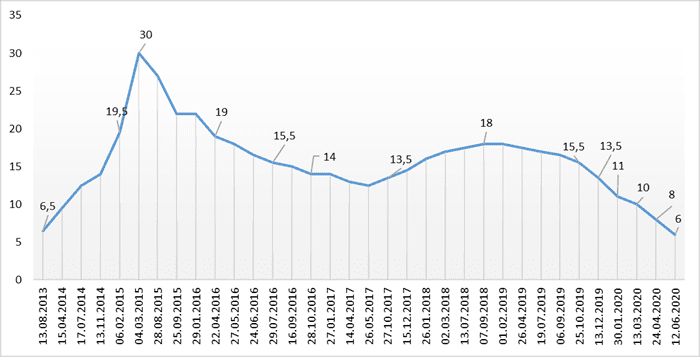Dynamics of changes in discount rate of NBU.

NBU

The National Bank of Ukraine (NBU) on January 26 made a decision to revoke the banking license and liquidate Misto Bank (Odesa), according to the regulator’s website on Wednesday.
“The NBU, at the suggestion of the Deposit Guarantee Fund, made a decision dated January 26, 2021 No. 25-RSh to revoke the banking license and liquidate Misto Bank,” the message said.
As reported, on December 14, the NBU classified Misto Bank as insolvent due to a decrease in capital ratios by 50% or more from the minimum established level due to the loss of one of its main assets – a soybean processing plant in Kherson region, with a book value of over UAH 271 million, or almost 17% of all bank assets.
Misto Bank was founded in 1993. According to the NBU, as of January 1, 2020, the main shareholders of the financial institution were Fursin, who directly and indirectly owned 97.180668% of the bank’s shares, and Latvian citizen Igor Buimister with 1.811499%.
As of October 1, 2020, the bank ranked 53rd in terms of total assets (UAH 1.498 billion) among 74 banks operating in the country, the press service of the central bank said on Monday.
Dynamics of changes in discount rate of NBU.

NBU

The National Bank of Ukraine (NBU) has excluded from the State Register of Financial Institutions such companies as׃ Credit Institution Credit Commerce LLC, Financial Company Monopolium Finance LLC, Finance and Credit Group Chaika LLC on the basis of their applications.
As reported on the regulator’s website, the relevant decisions were made by the NBU Committee on Supervision and Regulation of Non-Bank Financial Services Markets at a meeting on December 11, 2020.
According to the NBU, Credit Commerce had one license to issue loans, financial loans as well. As of September 30, 2020, the volume of assets of this institution was UAH 10.7 million, or 0.006% of the total assets of financial companies.
Monopolium Finance had three licenses: for the provision of guarantees and sureties, loans, financial loans, as well as factoring services. The licenses were revoked at a committee meeting on November 20. The company’s assets amounted to UAH 403.9 million, or 0.2% of the total assets of financial companies.
Finance and Credit Group Chaika had one license for issuing loans, including financial ones. The license was revoked on July 30, the volume of assets is UAH 5.9 million, or 0.003% of the total assets of financial companies.

The National Bank of Ukraine (NBU) is oriented on the growth of the country’s international reserves in 2020 from $25.3 billion at the beginning of the year to more than $27 billion at the end of the year, Deputy Governor of the National Bank Yurii Heletii has said.
“The indicator of international reserves will be higher than at the beginning of the year. Let me remind you that at the beginning of the year it was $25.3 billion. Our target is more than $27 billion,” he said.
According to the banker, the final volume of international reserves will depend on placements by the Ministry of Finance.
He explained that in the October forecast of the NBU, which assumed that international reserves at the end of this year will amount to $29 billion, it was planned to receive financing from the IMF, the World Bank and the EU.
According to the official, the state of international reserves is satisfactory and, according to the composite criterion, which is calculated according to the EU methodology, exceeds 90%.
As reported, the European Commission, on behalf of the European Union, issued EUR 600 million to Ukraine as part of the macro-financial assistance program related to COVID-19.

The National Bank of Ukraine (NBU) sold $8.7 million in the interbank foreign exchange market from October 5 to October 9, which is 83.1% less than a week earlier ($51.1).
According to the data on the website of the central bank posted on Friday, October 9, during the specified period, the NBU only sold currency and conducted all interventions at a single rate.
According to the central bank, $500,000 was purchased at the best purchase and sale price, and $8.2 million at a single rate.
In general, since the beginning of the year, the regulator bought $4.509 billion into the reserves, sold $3.363 billion, including in March it spent $2.2 billion on supporting the hryvnia, $368.7 million in July, while the central bank’s net purchase in April was $678.80 million, in May it was $660.6 million, in June – $1.155 billion and in August – $460.5 million and in September – $34 million.